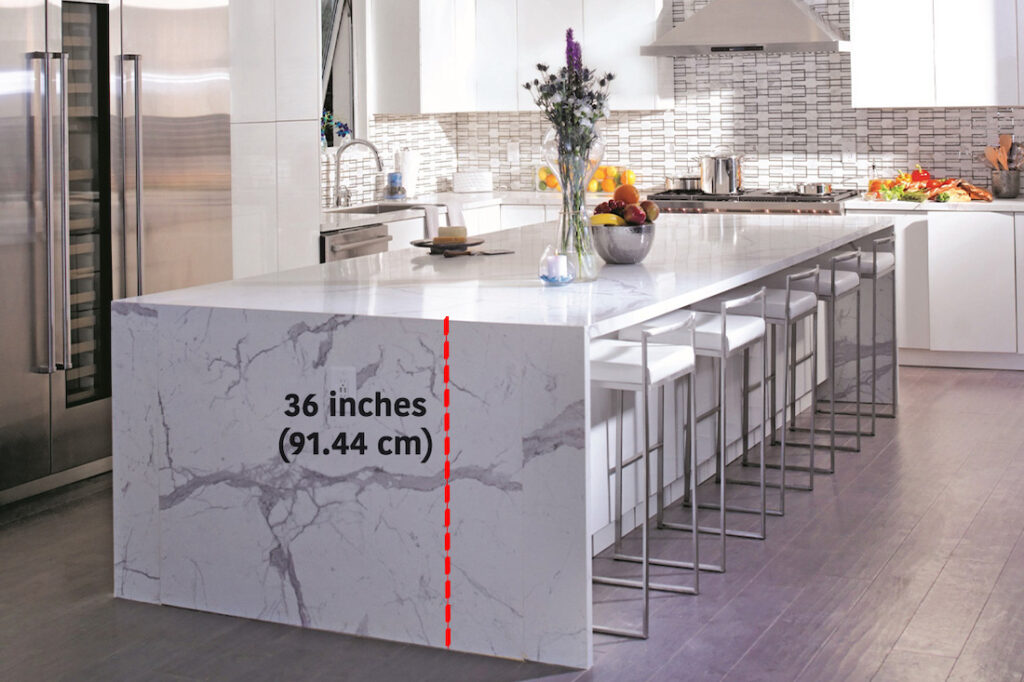The kitchen island is often the centerpiece of a modern kitchen, providing additional counter space and storage as well as a place to eat, prep food, and socialize. But when it comes to choosing the right height for your kitchen island, it can be tricky to determine the best option. In this article, we will explore the standard height for kitchen islands, the factors that can affect kitchen island height, and how to determine the right height for your kitchen island. We will also provide some tips for customizing your kitchen island height to suit your needs and preferences.
Table of Contents
What is the Standard Height for a Kitchen Island?
The standard height for a kitchen island is 36 inches (91.44 cm), which is the same height as most kitchen counters and appliances. This height is considered to be the most comfortable and ergonomic for most people, as it allows them to comfortably chop, prep, and cook food without straining their backs, shoulders, or wrists.

However, it is important to note that the standard kitchen island height may not be suitable for everyone, and it may need to be adjusted based on individual factors and preferences. In the next section, we will discuss some of the factors that can affect kitchen island height.
Factors that Affect Kitchen Island Height
There are several factors that can affect the ideal height for a kitchen island, including ergonomics, countertop material, and personal preferences.
Ergonomics
One of the most important factors to consider when choosing the height of your kitchen island is ergonomics. The height of your kitchen island should allow you to comfortably chop, prep, and cook food without straining your back, shoulders, or wrists. If the kitchen island is too low, you may have to bend over and hunch your shoulders, which can lead to discomfort and even pain over time. On the other hand, if the kitchen island is too high, you may have to reach up and stretch your arms, which can also lead to discomfort and strain.
Countertop Material
The type of material used for the countertop of your kitchen island can also affect its ideal height. For example, if you choose a heavy stone countertop such as granite or marble, you may need to raise the height of your kitchen island to compensate for the additional weight. This will prevent the island from sagging or leaning, and it will also make it easier to use the countertop for tasks such as chopping and food prep.
Personal Preferences
Ultimately, the ideal height for your kitchen island will also depend on your personal preferences and the needs of your family. Some people may prefer a lower kitchen island that is easier to use for tasks such as rolling out dough or cutting vegetables, while others may prefer a higher island that is more comfortable for standing and socializing. It is important to consider the specific activities that will take place on your kitchen island and choose a height that is comfortable and functional for those tasks. In the next section, we will discuss how to determine the right height for your kitchen island.
How to Determine the Right Height for Your Kitchen Island
To determine the right height for your kitchen island, there are several factors that you should consider, including your own height and comfort, your kitchen workflow, and the height of your other countertops.
Consider Your Own Height and Comfort
The first step in determining the right height for your kitchen island is to consider your own height and comfort. Think about the tasks that you will be performing on the island, such as chopping, prep, and cooking, and choose a height that allows you to comfortably and easily perform those tasks. If you are tall, you may prefer a slightly higher kitchen island, while if you are shorter, you may prefer a lower kitchen island.
Think About Your Kitchen Workflow
Another important factor to consider when choosing the height of your kitchen island is your kitchen workflow. If you have a traditional kitchen with a separate cooking area and dining area, you may want to match the height of your kitchen island to the height of your stove and oven. This will create a smooth and seamless transition between the two areas, and it will also make it easier to transfer food and ingredients between the island and the stove.
Take into Account the Height of Your Other Countertops
Finally, you should also consider the height of your other countertops when determining the right height for your kitchen island. If your kitchen has a separate bar area with a raised eating counter, for example, you may want to match the height of your kitchen island to the height of the bar counter. This will create a cohesive and harmonious look, and it will also make it easier to move between the different countertops in your kitchen. In the next section, we will provide some tips for customizing your kitchen island height to suit your needs and preferences.
Tips for Customizing Your Kitchen Island Height
If the standard kitchen island height of 36 inches (91.44 cm) doesn’t work for you or if you want to customize the height of your kitchen island to suit your specific needs and preferences, there are several options that you can consider.
Use Adjustable Feet or Casters
One option for customizing the height of your kitchen island is to use adjustable feet or casters. These are small, adjustable legs or wheels that can be attached to the bottom of your kitchen island, allowing you to easily raise or lower the island to the desired height. This can be a convenient and practical solution, especially if you have a multi-level kitchen or if you plan to use your kitchen island for a variety of tasks and activities.
Consider a Multi-Level Kitchen Island
Another option for customizing the height of your kitchen island is to choose a multi-level design. This type of island has different countertop heights on different sections, allowing you to have a lower area for prep and cooking, a higher area for eating and socializing, and a middle area for storage and additional counter space. This can be a great way to create a versatile and functional kitchen island that can accommodate different activities and needs.
Add a Raised Eating Counter or Bar
Finally, if you have a separate bar area or eating counter in your kitchen, you can customize the height of your kitchen island by adding a raised eating counter or bar. This is a small, elevated section of the island that is the same height as your bar counter or eating counter, allowing you to comfortably move between the two areas and use them for different tasks and activities. This can be a great way to create a cohesive and harmonious look in your kitchen.
See also: Can you use a kitchen island as a dining table?

Hi, I’m Jen from New Mexico. I have been working from home as a graphic designer for a long time. While working at home, I realized that I enjoy spending time in the kitchen. The kitchen is my biggest hobby. I set up this site to relay the products and experiences I’ve tried. I review many kitchen equipment and share them with you!
